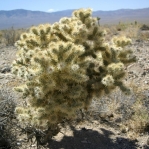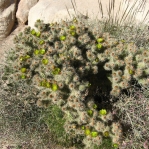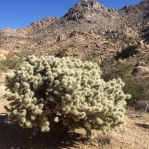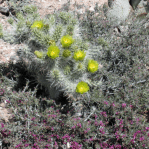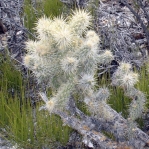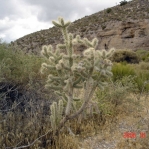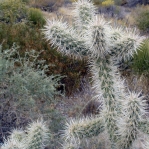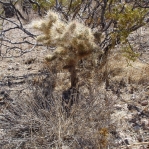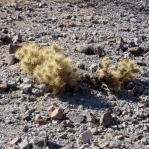Engelmann & J. M. Bigelow. 1856. Proceedings of the American Academy of Arts and Sciences 3: 305
Herbarium specimen; Herbarium specimen; Herbarium specimen; Herbarium specimen; Drawing (Britton and Rose, v 1, 1919)
Original description
Flora of North America treatment
What is Cylindropuntia echinocarpa?
Cylindropuntia echinocarpa is a common cholla in much of the Mojave and Sonoran deserts. It ranges from 50 to 1700+ m in elevation in a wide variety of habitats.
Details
C. echinocarpa is morphologically variable, ranging from low, densely branched shrubs to tree-like shrubs to 2 m tall. Stems are 3 to 12 cm long by 1 to 2.5 cm wide with 6 to 22 white, yellow, tan, or occasionally red-brown spines which obscure the stems. Sheaths range from white to yellow and are baggy. The flowers are yellow-green and sometimes tinged orange. Filaments are greenish-white to yellow. The styles and stigmas are white to light green. Fruits are tan, dry, and densely spiny. C. echinocarpa is diploid (2n = 22)
C. echinocarpa is known to hybridise with C. acanthocarpa (C. ×deserta), C. whipplei, and C. munzii. A single hybrid individual between C. echinocarpa and C. ramosissima has also been found. In his 1969 book The Cacti of Arizona, Benson designated a new taxon Opuntia wigginsii. However, it is obvious, even from the type specimen of “O. wigginsii,” that it is merely a juvenile form of C. echinocarpa. C. echinocarpa has been reported as a species parent (i.e., ancestral to) of C. fosbergii, but there is no morphological or genetic evidence to support this claim.

